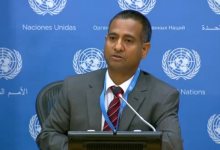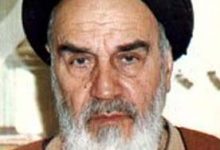Aadel Collection
Iran’s minorities are a potent force
Iran's minorities are a potent force
Staats, David R
The Sun (1837-1985); Dec 23, 1979; ProQuest Historical Newspapers: Baltimore Sun, The (183 7-1986)
pg. Ki
an's minorities are a potent force
By DAVID II . STAATS
The Kurds of have a a '1ng “A
root which has y Implanted Itself
cannot hatIng up by a gentle breeze' The
roots sunk centuries ago by the Kurds,
Azerbaijanis and Iran's other highly ne-
tionalisticand numerous ethnic minorities
are deep and show no sign of loosenln&
even under the strain of storm winds from
Tehrao and Qoin. On the contrary, they
stir and embed themselves more deeply
Howpo ularethemlnorltynalion
alitles of who comprise almost half
its population? And to what purpose Is
their determination?
The minority problem of Ia Is not
merely a domestic Issue, It Is an mterna-
tional one because of the historical, na-
tional and cultural links that moat of
Iran's major national minorities have to
large communities In adjacent countries.
Only half of fran's 36 million people are
ethnic Persians. The other 18 million area
complex mixture 0! overlapping ethnic
and reI gIous groups actively seeking au.
tonomy for their respective native re-
gions.
fran'seththc minorities joined In the Is .
lamb revolution for both national and re-
ligious reasons. However, the issue of re-
gional autonomy, which thesemlnorityna-
tbonalliles espouse, directly strikes at the
fundamental governing principle of the Is.
lamb Republic by pitttn g demands for lo-
cal seWru le by secular authorities against
an increasingly Intransigent centralized
theocracy
Article V of the new iranian Comtltu
lion establishes the exclusive tight of the
Seej K2 ,coL I
Mr. Stuts,atellow at the Research Instl•
tale for Inner MIan Studies at Indiana
University, was assisted In the prepara.
lion of this article by Tanla A. Jacques, a
gradnale student In the Departtneat of
UrlicsndMtaIcStadiesatIndIanL
Or, 1te y Usa Ann Zock
Reproduced with permission of the copyright owner. Further reproduction prohibited without permission.
clergy to govern. As the supreme Inter-
preter of Islamic law, Ayatollah Rubollah
Khomeini is empowered to veto any and
all legislation which, in his opinion, does
not conform to the Muslim legal code.
Growing frustration with the sweeping
powers which allow Ayatollah Khomeini
to rule virtually by decree was the princi-
pal cause behind the resignation of former
Iraniaa Prime Minister Mebdi Bazargan,
who likened secular government under
these conditions to “a knife without a
blade?'
The eipectations of the Eurds, Aier.
baljanls and Iran's other ethnic minorities
for a new era of political liberalism, fol-
lowing the downfall of Shah Mohammad
Reza Pahiavi. were not utopian. However,
thestubbom refusal by Ayatollah Khomei-
ni even to consider their petitions for re-
gional self-rule has created a serious polit-
ical Impasse. Until some sort of compro-
misc on the autonomy Issue is reached, the
ethnic minorities' confidence in Iran's new
political system will continue to diminish
to the point where, unless dramatic steps
are taken to reverse the erosion, the mi-
nority nationalities may consider casting
their lots with foreign powers in the re-
gion to gain Independence from Tebran.
At present, however, none of these peo.
pies advocates separatism, but all are en-
gaged in a determined struggle for region-
al national autonomy as well as for ex-
panded opportunities in the iranian econo
my. As Kurdish leader Sheikh Ezzeedin
Rosselni stated: ‘Fundamentally, we ac-
cept the role of the central government in
foreign and defense policy. But beyond
that, we want to run our own show.”'
Of the major non -I'ersian nation-
alities of the four million iranian-
speaking urds, who are Sunni Muslims
(and with whom the other eight million
Kurds in Iraq, Syria, Turkey and the Sovi.
et Union, constitute the fourth-largest eth-
nic group In the Middle East), have along
history of rebellion against central au-
thority. These revolts inevitably have
drawn in the major powers of the region,
thereby elevating a local uprising by trib-
al dissidents to international significance.
This is why unrest among Iran's minority
nationalities is a serious problem of secu-
rity not only for Tehran but also for other
world capitals.
This history of the Kurdish national lib-
eration movement is a classic case study
of such manipulation of a local conflict by
regional and global powers for their mdi-
vidual political advantage. Briefly, the
Kurdish national liberation movement be-
gan to take a definite political form by the
end of the last century Kurdish newspa-
per was established in an In 1897, whIch
published irregularly until It was sup-
pressed by Persian authorities In 1902. Its
activities were resumed In 1908, In istan-
bul, by a newly formed Kurdish jiolitlcal
action party and Its Kurdish cultural soci-
ety.
During World War! the Kurds pressed
their demands for an independent Kurdish
homeland from their new headquarters In
Cairo. Their efforts were rewarded In
1920 by the Treaty of Sevres, which pro.
vided for the creation of an independent
Kurdestan; but the treaty was never rati.
fled. The Treaty of Lausanne (1923),
which formally ended hostilities In the
Middle East, made no mention of the
Kurds, In fact, the chief Turkish delegate
to the Lausannqçonference, lsmetPasha,
himself a Kurd declared (wrongly) that
because the Kurds are ethnic Turks and
Muslims, their national and religious
rights could be guaranteed within the
Turkish state, and that no independent
homeland for the Kurds was necessary.
Following World War H, a Kurdish
state was created with Soviet backing In
Iranian Kurdestan. When the United
States and the Western allies forced Mos-
cow to withdraw Its troops from the area,
the shah's army reestablished Iranian sov-
ereignty over thearea.
Ia 1961, Kurdlsh leader Muflab Mus-
tafa Barrani organized Kurdish tribesmen
In Iraq In armed resistance to the Bagh-
dad government. After 10 years of pro-
tracted guerrilla warfare, the Iraqis in
March, 1970, agreed tea plan granting an-
tonomytotheKurds fouryearsbence.
The shah of Iran drew the Iraqi Kurds
under Mr. Barzanl Into his border dispute
with the Baathlst government in Baghdad
by arranging for them to receive assist-
ance from the US. Central Intelligence
Agency, which then-Secretary of State
Henry A. Kissinger engineered In return
for the shah's support of the Nixon Doc-
trine.
When the actual tennsof the autonomy
guarantee were delivered to Mr. Barzani
In March, 1974, he rejected them as Inade-
quate and resumed hostilities with the
backing of the shah and the CIA. Within a
year the shah bad reached a compromise
on the border issue with the Iraqis and
withdrew his support of the Kurdlsh reb-
els, which left the tribesmen to defend
themselves as best they could against Ira-
qi armor and aircralL Kurdisb resistance
quickly melted, Mr. Barzani took refuge In
Tebran.
- Unlike the overwhelming majority of
the other Turkie-speaking peoples of the
world, the five million Azerbaijanis of
‘belong to the Shilte branch of Islam.
Their total national territory and popula.
tlnn is divided nearly equally between
and the Soviet Union.
a 1945, a short-lived independent
Azerhaljaai state was created by the So-
viet lJnloa , As with the case of Soviet.
backed Kurdestan, Moscow's post-war In-
terference In Iranian Azerbaijan was
brought to a quick end by decisive action
by the United States and the other West.
era powers. The Azerbaljanis are
the second-largest ethnic group In
and they are concentrated in the coun ry's
populous northwestern region where they
form the majority population.
Like the Kurds and the Azeris, the Ira.
alan-speaking, Sunni BeIuchls are divided
among several countries of the region—
Pakistan and Afghanistan In bran
ey number about 700,000, and are more
closely related lInguistically to the Push.
tu-speaking Afghanls than to the Farsi.
speaking Persians. The Baluçhls Inhabit
thesoutheastern highlands of B'
Another minority elemen( a the
Arab population of the oil-rich prov cc of
Khuzestan. Like the other Arabs of the
Middle East, Ehuzestan Arabs belong to
the Sunni sect of Islam. Most of Iran's two
million Arabs resent what they feel Is the
Inequitable distribution of od revenues
from the petroleum industry which Is lo-
catedon their territory.
Although the fabric of Iranian society
is an intricate weave of many colored
threads into bold, individualistic patterns,
Ayatollah Khomeini Is using his brand of
islamic fundameutallsni to bleach out all
of these distinctive, and therefore dis'
tract lng , patterns.
Himself the principal political benefici-
ary of last year's rioting In Tabrlz by the
Azerbaijani Turks, the ayatollah today re-
gards their same unfulfilled aspirations
I or regional national autonomy within the
iranian Islamic Republic as nothing less
than “an insult to Islam. ” And, according
to the ayatollah of Tebran, Hussein All
Montazerl , the struggle for Kurdish na.
ional and religious rights by the Kurdish
iDemocratic Party.is being led by “agents
of Zionism and corruption.”
Ayatollah Khomeini and his supporters
are guilty of underestimatIng the volatil-
Ity and revolutionary potential of these
ethnic minorities, both Individually and
collectively. Ills failure to reach a com-
promise with the ethnic minorities on the'
issue of national autonomy could well
forge a coordinated policy of political
struggle among these peoples, leading to
his overthrow in favor of a more enlight-
ened national leadership under someone
such as the Ayatollah Mohammad Kazem
Shariat-MadarL
Further frustration of the ethnic mi-
norities' quest for their national rights.
could pursuade some to accept the patron-
age of a foreign power for the region, As..
has been shown In the case ci the Kurds,
such a combination of Interests is the rule
rather than the exception. The current
head of the Iraqi government, Saddam
HusseIn Takrltl, who came to power in
• July of this year, announced a program of
• naw concessions to the Kurds of his coun-
try, including the granting of permission
‘to 1,000 Kurdlab tribesmen to return to
their native Kurdestan.
In view of recent reports of Incidents
along the Iraqi-Iranian frontIer, one can-s
not Ignore the possibility that the Iraqi
government Is now considering substan-
tial material support to the Kurds of iran,
just as the shah supported Kurdish Insur-
gents In Iraq earlier In the decade.
One Interesting question which remains
is the attitude of the SovIet Union, Iran's
pro-Moscow Communist Party, Tudeh,
publicly supports Ayatollah Khomeini on
the autonomy question, splitting the coun-
try's Ieft-wlng parties.The real problem
for Soviet poJ p akers Is whether to try
to take all ot'm!br just parts of It.
Unlike Ayatollah Khomeini, the Soviets
are highly skilled at manipulating the nat-
ural political forces within a society, and
the current crisis of Iran's ethnic minor!-”
ties In the struggle ‘for their national
rlglstsoffers Moscow tes ptIng opportuni-
ties. As Boris Yerasov, a Soviet specialist.
on national liberation movements, corn-
‘meatS: “Arblt aryatteztipts to ignore'the
national and cultural heritage are doomed
to failure,” .
Currently, onjy t cvo governments af-
fected directly by the 'utaettled conditions
In Fare heeding this adm nltion.
These are 1 nd the United States.
SAUDI
ARABIA
Reproduced with permission of the copyright owner. Further reproduction prohibited without permission.







